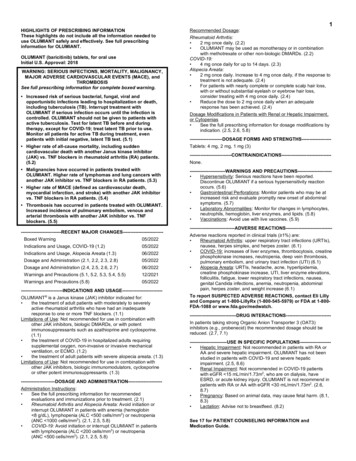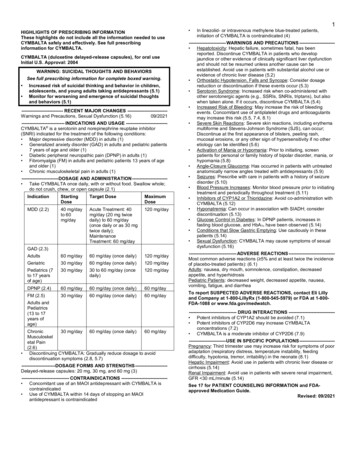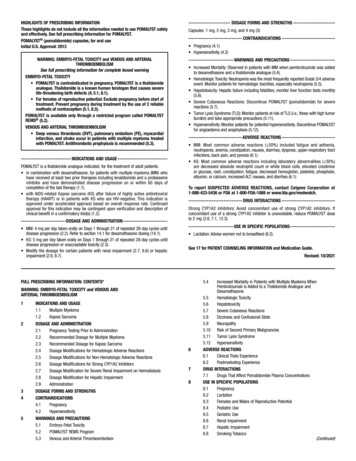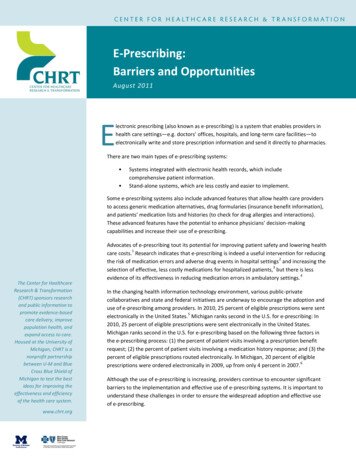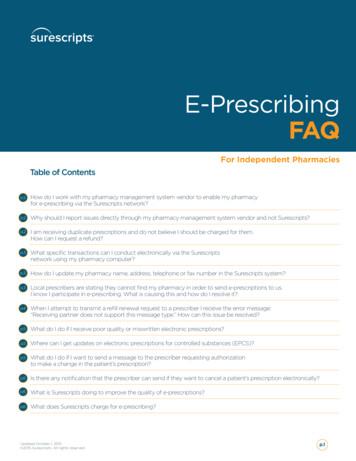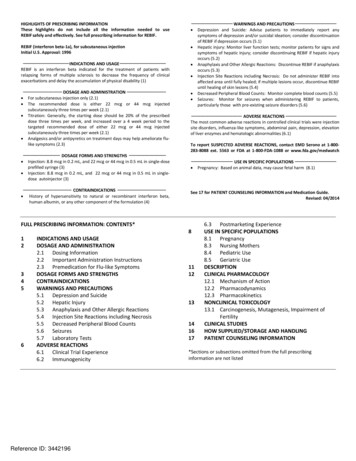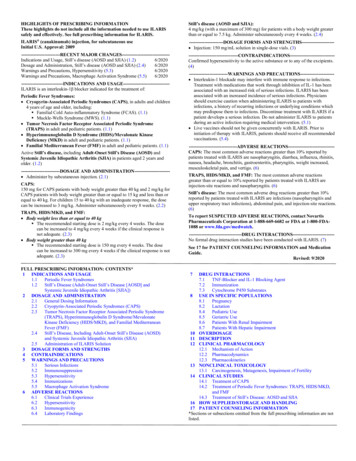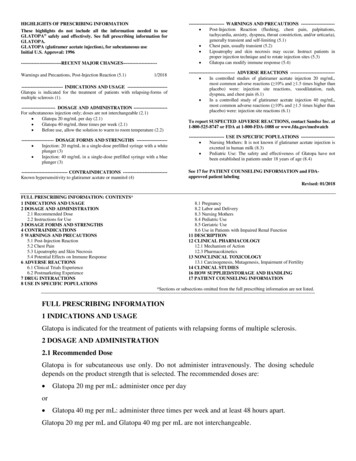
Transcription
HIGHLIGHTS OF PRESCRIBING INFORMATIONThese highlights do not include all the information needed to useGLATOPA safely and effectively. See full prescribing information forGLATOPA.GLATOPA (glatiramer acetate injection), for subcutaneous useInitial U.S. Approval: 1996--------------------------RECENT MAJOR CHANGES---------------------Warnings and Precautions, Post-Injection Reaction (5.1)1/2018--------------------------- INDICATIONS AND USAGE -------------------------Glatopa is indicated for the treatment of patients with relapsing-forms ofmultiple sclerosis (1).---------------------- DOSAGE AND ADMINISTRATION ---------------------For subcutaneous injection only; doses are not interchangeable (2.1) Glatopa 20 mg/mL per day (2.1) Glatopa 40 mg/mL three times per week (2.1) Before use, allow the solution to warm to room temperature (2.2)--------------------- DOSAGE FORMS AND STRENGTHS ------------------- Injection: 20 mg/mL in a single-dose prefilled syringe with a whiteplunger (3) Injection: 40 mg/mL in a single-dose prefilled syringe with a blueplunger (3)------------------------------ CONTRAINDICATIONS ----------------------------Known hypersensitivity to glatiramer acetate or mannitol (4)----------------------- WARNINGS AND PRECAUTIONS --------------------- Post-Injection Reaction (flushing, chest pain, palpitations,tachycardia, anxiety, dyspnea, throat constriction, and/or urticaria),generally transient and self-limiting (5.1) Chest pain, usually transient (5.2) Lipoatrophy and skin necrosis may occur. Instruct patients inproper injection technique and to rotate injection sites (5.3) Glatopa can modify immune response (5.4)------------------------------ ADVERSE REACTIONS ---------------------------- In controlled studies of glatiramer acetate injection 20 mg/mL,most common adverse reactions ( 10% and 1.5 times higher thanplacebo) were: injection site reactions, vasodilatation, rash,dyspnea, and chest pain (6.1) In a controlled study of glatiramer acetate injection 40 mg/mL,most common adverse reactions ( 10% and 1.5 times higher thanplacebo) were: injection site reactions (6.1)To report SUSPECTED ADVERSE REACTIONS, contact Sandoz Inc. at1-800-525-8747 or FDA at 1-800-FDA-1088 or www.fda.gov/medwatch----------------------- USE IN SPECIFIC POPULATIONS --------------------- Nursing Mothers: It is not known if glatiramer acetate injection isexcreted in human milk (8.3) Pediatric Use: The safety and effectiveness of Glatopa have notbeen established in patients under 18 years of age (8.4)See 17 for PATIENT COUNSELING INFORMATION and FDAapproved patient labelingRevised: 01/2018FULL PRESCRIBING INFORMATION: CONTENTS*1 INDICATIONS AND USAGE2 DOSAGE AND ADMINISTRATION2.1 Recommended Dose2.2 Instructions for Use3 DOSAGE FORMS AND STRENGTHS4 CONTRAINDICATIONS5 WARNINGS AND PRECAUTIONS5.1 Post-Injection Reaction5.2 Chest Pain5.3 Lipoatrophy and Skin Necrosis5.4 Potential Effects on Immune Response6 ADVERSE REACTIONS6.1 Clinical Trials Experience6.2 Postmarketing Experience7 DRUG INTERACTIONS8 USE IN SPECIFIC POPULATIONS8.1 Pregnancy8.2 Labor and Delivery8.3 Nursing Mothers8.4 Pediatric Use8.5 Geriatric Use8.6 Use in Patients with Impaired Renal Function11 DESCRIPTION12 CLINICAL PHARMACOLOGY12.1 Mechanism of Action12.3 Pharmacokinetics13 NONCLINICAL TOXICOLOGY13.1 Carcinogenesis, Mutagenesis, Impairment of Fertility14 CLINICAL STUDIES16 HOW SUPPLIED/STORAGE AND HANDLING17 PATIENT COUNSELING INFORMATION*Sections or subsections omitted from the full prescribing information are not listed.FULL PRESCRIBING INFORMATION1 INDICATIONS AND USAGEGlatopa is indicated for the treatment of patients with relapsing forms of multiple sclerosis.2 DOSAGE AND ADMINISTRATION2.1 Recommended DoseGlatopa is for subcutaneous use only. Do not administer intravenously. The dosing scheduledepends on the product strength that is selected. The recommended doses are: Glatopa 20 mg per mL: administer once per dayor Glatopa 40 mg per mL: administer three times per week and at least 48 hours apart.Glatopa 20 mg per mL and Glatopa 40 mg per mL are not interchangeable.
2.2 Instructions for UseRemove one blister-packaged prefilled syringe from the refrigerated carton. Let the prefilledsyringe stand at room temperature for 20 minutes to allow the solution to warm to roomtemperature. Visually inspect the syringe for particulate matter and discoloration prior toadministration. The solution in the syringe should appear clear, colorless to slightly yellow. Ifparticulate matter or discoloration is observed, discard the syringe.Areas for subcutaneous self-injection include arms, abdomen, hips, and thighs. The prefilledsyringe is for single use only. Discard unused portions.3 DOSAGE FORMS AND STRENGTHS Injection: 20 mg per mL in a single-dose, prefilled syringe with a white plunger. Forsubcutaneous use only.Injection: 40 mg per mL in a single-dose, prefilled syringe with a blue plunger. Forsubcutaneous use only.4 CONTRAINDICATIONSGlatopa is contraindicated in patients with known hypersensitivity to glatiramer acetate ormannitol.5 WARNINGS AND PRECAUTIONS5.1 Post-Injection ReactionApproximately 16% of patients exposed to glatiramer acetate injection 20 mg per mL in the fiveplacebo-controlled trials compared to 4% of those on placebo, and approximately 2% of patientsexposed to glatiramer acetate injection 40 mg per mL in a placebo-controlled trial compared tonone on placebo, experienced a constellation of symptoms that may occur within minutes afterinjection and included at least two of the following: flushing, chest pain, palpitations,tachycardia, anxiety, dyspnea, constriction of the throat, and urticaria. In general, thesesymptoms have their onset several months after the initiation of treatment, although they mayoccur earlier, and a given patient may experience one or several episodes of these symptoms.Whether or not any of these symptoms actually represent a specific syndrome is uncertain.Typically, the symptoms were transient and self-limited and did not require treatment; however,there have been reports of patients with similar symptoms who received emergency medical care.Whether an immunologic or nonimmunologic mechanism mediates these episodes, or whetherseveral similar episodes seen in a given patient have identical mechanisms, is unknown.5.2 Chest PainApproximately 13% of glatiramer acetate injection 20 mg per mL patients in the five placebocontrolled studies compared to 6% of placebo patients, and approximately 2% of patientsexposed to glatiramer acetate injection 40 mg per mL in a placebo-controlled trial compared to1% of placebo patients, experienced at least one episode of transient chest pain. While some ofthese episodes occurred in the context of the Post-Injection Reaction described above, many didnot. The temporal relationship of this chest pain to an injection was not always known. The pain
was usually transient, often unassociated with other symptoms, and appeared to have no clinicalsequelae. Some patients experienced more than one such episode, and episodes usually began atleast 1 month after the initiation of treatment. The pathogenesis of this symptom is unknown.5.3 Lipoatrophy and Skin NecrosisAt injection sites, localized lipoatrophy and, rarely, injection site skin necrosis may occur.Lipoatrophy occurred in approximately 2% of patients exposed to glatiramer acetate injection 20mg per mL in the five placebo-controlled trials compared to none on placebo, and 0.5% ofpatients exposed to glatiramer acetate injection 40 mg per mL in a single placebo-controlled trialand none on placebo. Skin necrosis has only been observed in the post-marketing setting.Lipoatrophy may occur at various times after treatment onset (sometimes after several months)and is thought to be permanent. There is no known therapy for lipoatrophy. To assist in possiblyminimizing these events, the patient should be advised to follow proper injection technique andto rotate injection sites with each injection.5.4 Potential Effects on Immune ResponseBecause glatiramer acetate injection can modify immune response, it may interfere with immunefunctions. For example, treatment with glatiramer acetate injection may interfere with therecognition of foreign antigens in a way that would undermine the body’s tumor surveillance andits defenses against infection. There is no evidence that glatiramer acetate injection does this, butthere has not been a systematic evaluation of this risk. Because glatiramer acetate injection is anantigenic material, it is possible that its use may lead to the induction of host responses that areuntoward, but systematic surveillance for these effects has not been undertaken.Although glatiramer acetate injection is intended to minimize the autoimmune response tomyelin, there is the possibility that continued alteration of cellular immunity due to chronictreatment with glatiramer acetate injection may result in untoward effects.Glatiramer acetate-reactive antibodies are formed in most patients receiving glatiramer acetate.Studies in both the rat and monkey have suggested that immune complexes are deposited in therenal glomeruli. Furthermore, in a controlled trial of 125 RRMS patients given glatiramer acetateinjection 20 mg per mL, subcutaneously every day for 2 years, serum IgG levels reached at least3 times baseline values in 80% of patients by 3 months of initiation of treatment. By 12 monthsof treatment, however, 30% of patients still had IgG levels at least 3 times baseline values, and90% had levels above baseline by 12 months. The antibodies are exclusively of the IgG subtypeand predominantly of the IgG-1 subtype. No IgE type antibodies could be detected in any of the94 sera tested; nevertheless, anaphylaxis can be associated with the administration of most anyforeign substance, and therefore, this risk cannot be excluded.6 ADVERSE REACTIONSThe following serious adverse reactions are described elsewhere in the labeling: Post-Injection Reaction [see Warnings and Precautions (5.1)] Chest Pain [see Warnings and Precautions (5.2)]
Lipoatrophy and Skin Necrosis [see Warnings and Precautions (5.3)] Potential Effects on Immune Response [see Warnings and Precautions (5.4)]6.1 Clinical Trials ExperienceBecause clinical trials are conducted under widely varying conditions, adverse reaction ratesobserved in the clinical trials of a drug cannot be directly compared to rates in the clinical trialsof another drug and may not reflect the rates observed in practice.Incidence in Controlled Clinical TrialsGlatiramer Acetate Injection 20 mg per mL per dayAmong 563 patients treated with glatiramer acetate injection in blinded placebo-controlled trials,approximately 5% of the subjects discontinued treatment because of an adverse reaction. Theadverse reactions most commonly associated with discontinuation were: injection site reactions,dyspnea, urticaria, vasodilatation, and hypersensitivity. The most common adverse reactionswere: injection site reactions, vasodilatation, rash, dyspnea, and chest pain.Table 1 lists signs and symptoms that occurred in at least 2% of patients treated with glatirameracetate injection 20 mg per mL in the placebo-controlled trials. These signs and symptoms werenumerically more common in patients treated with glatiramer acetate injection than in patientstreated with placebo. Adverse reactions were usually mild in intensity.Table 1. Adverse reactions in controlled clinical trials with an incidence 2% of patientsand more frequent with glatiramer acetate injection (20 mg per mL daily) thanwith placeboBlood And Lymphatic SystemDisordersCardiac DisordersEye DisordersGastrointestinal DisordersGeneral Disorders AndAdministrationSite ConditionsGlatiramerAcetateInjection20 mg/mL(n 563)Placebo(n 564)Lymphadenopathy7%3%PalpitationsTachycardiaEye 7%2%4%2%1%2%11%4%1%Injection Site Erythema43%10%Injection Site PainInjection Site PruritusInjection Site MassAstheniaPainInjection Site Edema40%27%26%22%20%19%20%4%6%21%17%4%
Immune System DisordersInfections And InfestationsMetabolism And Nutrition DisordersMusculoskeletal And ConnectiveTissue DisordersNeoplasms Benign, Malignant AndUnspecified (Incl Cysts And Polyps)Nervous System DisordersPsychiatric DisordersRenal And Urinary DisordersRespiratory, Thoracic AndMediastinalDisordersSkin And Subcutaneous TissueDisordersVascular Disorders1.GlatiramerAcetateInjection20 mg/mL(n 563)13%9%8%8%6%Placebo(n %1%1%1%2%1%0%2%28%13%5%5%4%2%1%10%Benign Neoplasm of Skin2%1%TremorMigraineSyncopeSpeech DisorderAnxietyNervousnessMicturition Skin %1%1%5%Chest PainInjection Site InflammationEdemaInjection Site ReactionPyrexiaInjection SiteHypersensitivityLocal ReactionChillsFace EdemaEdema PeripheralInjection Site FibrosisInjection Site BronchitisGastroenteritisVaginal CandidiasisWeight IncreasedBack PainInjection site atrophy comprises terms relating to localized lipoatrophy at injection site
Adverse reactions which occurred only in 4 to 5 more subjects in the glatiramer acetate injectiongroup than in the placebo group (less than 1% difference), but for which a relationship toglatiramer acetate injection could not be excluded, were arthralgia and herpes simplex.Laboratory analyses were performed on all patients participating in the clinical program forglatiramer acetate injection. Clinically-significant laboratory values for hematology, chemistry,and urinalysis were similar for both glatiramer acetate injection and placebo groups in blindedclinical trials. In controlled trials one patient discontinued treatment due to thrombocytopenia (16x109/L), which resolved after discontinuation of treatment.Data on adverse reactions occurring in the controlled clinical trials of glatiramer acetate injection20 mg per mL were analyzed to evaluate differences based on sex. No clinically-significantdifferences were identified. Ninety-six percent of patients in these clinical trials were Caucasian.The majority of patients treated with glatiramer acetate injection were between the ages of 18and 45. Consequently, data are inadequate to perform an analysis of the adverse reactionincidence related to clinically-relevant age subgroups.Other Adverse ReactionsIn the paragraphs that follow, the frequencies of less commonly reported adverse clinicalreactions are presented. Because the reports include reactions observed in open and uncontrolledpremarketing studies (n 979), the role of glatiramer acetate injection in their causation cannotbe reliably determined. Furthermore, variability associated with adverse reaction reporting, theterminology used to describe adverse reactions, etc., limit the value of the quantitative frequencyestimates provided. Reaction frequencies are calculated as the number of patients who usedglatiramer acetate injection and reported a reaction divided by the total number of patientsexposed to glatiramer acetate injection. All reported reactions are included except those alreadylisted in the previous table, those too general to be informative, and those not reasonablyassociated with the use of the drug. Reactions are further classified within body systemcategories and enumerated in order of decreasing frequency using the following definitions:Frequent adverse reactions are defined as those occurring in at least 1/100 patients andinfrequent adverse reactions are those occurring in 1/100 to 1/1,000 patients.Body as a Whole:Frequent: AbscessInfrequent: Injection site hematoma, moon face, cellulitis, hernia, injection site abscess, serumsickness, suicide attempt, injection site hypertrophy, injection site melanosis, lipoma, andphotosensitivity reaction.Cardiovascular:Frequent: Hypertension.Infrequent: Hypotension, midsystolic click, systolic murmur, atrial fibrillation, bradycardia,fourth heart sound, postural hypotension, and varicose veins.
Digestive:Infrequent: Dry mouth, stomatitis, burning sensation on tongue, cholecystitis, colitis, esophagealulcer, esophagitis, gastrointestinal carcinoma, gum hemorrhage, hepatomegaly, increasedappetite, melena, mouth ulceration, pancreas disorder, pancreatitis, rectal hemorrhage, tenesmus,tongue discoloration, and duodenal ulcer.Endocrine:Infrequent: Goiter, hyperthyroidism, and hypothyroidism.Gastrointestinal:Frequent: Bowel urgency, oral moniliasis, salivary gland enlargement, tooth caries, andulcerative stomatitis.Hemic and Lymphatic:Infrequent: Leukopenia, anemia,pancytopenia, and phedema,Metabolic and Nutritional:Infrequent: Weight loss, alcohol intolerance, Cushing’s syndrome, gout, abnormal healing, andxanthoma.Musculoskeletal:Infrequent: Arthritis, muscle atrophy, bone pain, bursitis, kidney pain, muscle disorder,myopathy, osteomyelitis, tendon pain, and tenosynovitis.Nervous:Frequent: Abnormal dreams, emotional lability, and stupor.Infrequent: Aphasia, ataxia, convulsion, circumoral paresthesia, depersonalization,hallucinations, hostility, hypokinesia, coma, concentration disorder, facial paralysis, decreasedlibido, manic reaction, memory impairment, myoclonus, neuralgia, paranoid reaction, paraplegia,psychotic depression, and transient stupor.Respiratory:Frequent: Hyperventilation and hay fever.Infrequent: Asthma, pneumonia, epistaxis, hypoventilation, and voice alteration.Skin and Appendages:Frequent: Eczema, herpes zoster, pustular rash, skin atrophy, and warts.Infrequent: Dry skin, skin hypertrophy, dermatitis, furunculosis, psoriasis, angioedema, contactdermatitis, erythema nodosum, fungal dermatitis, maculopapular rash, pigmentation, benign skinneoplasm, skin carcinoma, skin striae, and vesiculobullous rash.
Special Senses:Frequent: Visual field defect.Infrequent: Dry eyes, otitis externa, ptosis, cataract, corneal ulcer, mydriasis, optic neuritis,photophobia, and taste loss.Urogenital:Frequent: Amenorrhea, hematuria, impotence, menorrhagia, suspicious papanicolaou smear,urinary frequency, and vaginal hemorrhage.Infrequent: Vaginitis, flank pain (kidney), abortion, breast engorgement, breast enlargement,carcinoma in situ cervix, fibrocystic breast, kidney calculus, nocturia, ovarian cyst, priapism,pyelonephritis, abnormal sexual function, and urethritis.Glatiramer Acetate Injection 40 mg per mL three times per weekAmong 943 patients treated with glatiramer acetate injection 40 mg per mL three times per weekin a blinded, placebo-controlled trial, approximately 3% of the subjects discontinued treatmentbecause of an adverse reaction. The most common adverse reactions were injection sitereactions, which were also the most common cause of discontinuation.Table 2 lists signs and symptoms that occurred in at least 2% of patients treated with glatirameracetate injection 40 mg per mL in the blinded, placebo-controlled trial. These signs andsymptoms were numerically more common in patients treated with glatiramer acetate injection40 mg per mL than in patients treated with placebo. Adverse reactions were usually mild inintensity.Table 2: Adverse reactions in a controlled clinical trial with an incidence 2% of patientsand more frequent with glatiramer acetate injection (40 mg per mL three times per week)than with placeboGeneral Disorders AndAdministration Site ConditionsInfections And InfestationsRespiratory, Thoracic and MediastinalInjection Site ErythemaInjection Site PainInjection Site MassInjection Site PruritusInjection Site EdemaPyrexiaInfluenza-like IllnessInjection Site InflammationChillsChest PainNasopharyngitisRespiratory Tract Infection ViralDyspneaGlatiramerAcetateInjection40 mg/mL(n 943)22%10%6%6%6%3%3%2%2%2%11%3%3%Placebo(n 461)2%2%0%0%0%2%2%0%0%1%9%2%0%
GlatiramerAcetateInjection40 mg/mL(n 943)DisordersVascular DisordersGastrointestinal DisordersSkin And Subcutaneous %2%2%Placebo(n 461)0%1%0%1%No new adverse reactions appeared in subjects treated with glatiramer acetate injection 40 mgper mL three times per week as compared to subjects treated with glatiramer acetate injection 20mg per mL per day in clinical trials and during postmarketing experience. Data on adversereactions occurring in the controlled clinical trial of glatiramer acetate injection 40 mg per mLwere analyzed to evaluate differences based on sex. No clinically significant differences wereidentified. Ninety-eight percent of patients in this clinical trial were Caucasian and the majoritywere between the ages of 18 and 50. Consequently, data are inadequate to perform an analysis ofthe adverse reaction incidence related to clinically-relevant age groups.6.2 Postmarketing ExperienceThe following adverse reactions have been identified during postapproval use of glatirameracetate injection. Because these reactions are reported voluntarily from a population of uncertainsize, it is not always possible to reliably estimate their frequency or establish a causalrelationship to drug exposure.Body as a Whole: sepsis; SLE syndrome; hydrocephalus; enlarged abdomen; allergic reaction;anaphylactoid reactionCardiovascular System: thrombosis; peripheral vascular disease; pericardial effusion; myocardialinfarct; deep thrombophlebitis; coronary occlusion; congestive heart failure; cardiomyopathy;cardiomegaly; arrhythmia; angina pectorisDigestive System: tongue edema; stomach ulcer; hemorrhage; liver function abnormality; liverdamage; hepatitis; eructation; cirrhosis of the liver; cholelithiasisHemic and Lymphatic System: thrombocytopenia; lymphoma-like reaction; acute leukemiaMetabolic and Nutritional Disorders: hypercholesterolemiaMusculoskeletal System: rheumatoid arthritis; generalized spasmNervous System: myelitis; meningitis; CNS neoplasm; cerebrovascular accident; brain edema;abnormal dreams; aphasia; convulsion; neuralgiaRespiratory System: pulmonary embolus; pleural effusion; carcinoma of lungSpecial Senses: glaucoma; blindnessUrogenital System: urogenital neoplasm; urine abnormality; ovarian carcinoma; nephrosis;kidney failure; breast carcinoma; bladder carcinoma; urinary frequency
7 DRUG INTERACTIONSInteractions between glatiramer acetate injection and other drugs have not been fully evaluated.Results from existing clinical trials do not suggest any significant interactions of glatirameracetate injection with therapies commonly used in MS patients, including the concurrent use ofcorticosteroids for up to 28 days. Glatiramer acetate injection has not been formally evaluated incombination with interferon beta.8 USE IN SPECIFIC POPULATIONS8.1 PregnancyPregnancy Category BAdministration of glatiramer acetate by subcutaneous injection to pregnant rats and rabbitsresulted in no adverse effects on offspring development. There are no adequate and wellcontrolled studies in pregnant women. Because animal reproduction studies are not alwayspredictive of human response, Glatopa should be used during pregnancy only if clearly needed.In rats or rabbits receiving glatiramer acetate by subcutaneous injection during the period oforganogenesis, no adverse effects on embryo-fetal development were observed at doses up to37.5 mg/kg/day (18 and 36 times, respectively, the therapeutic human dose of 20 mg/day on amg/m2 basis). In rats receiving subcutaneous glatiramer acetate at doses of up to 36 mg/kg fromday 15 of pregnancy throughout lactation, no significant effects on delivery or on offspringgrowth and development were observed.8.2 Labor and DeliveryThe effects of Glatopa on labor and delivery in pregnant women are unknown.8.3 Nursing MothersIt is not known if glatiramer acetate is excreted in human milk. Because many drugs are excretedin human milk, caution should be exercised when Glatopa is administered to a nursing woman.8.4 Pediatric UseThe safety and effectiveness of Glatopa have not been established in patients under 18 years ofage.8.5 Geriatric UseGlatopa has not been studied in elderly patients.8.6 Use in Patients with Impaired Renal FunctionThe pharmacokinetics of glatiramer acetate in patients with impaired renal function have notbeen determined.11 DESCRIPTIONGlatiramer acetate, the active ingredient of Glatopa, consists of the acetate salts of syntheticpolypeptides, containing four naturally occurring amino acids: L-glutamic acid, L-alanine, Ltyrosine, and L-lysine with an average molar fraction of 0.141, 0.427, 0.095, and 0.338,
respectively. The average molecular weight of glatiramer acetate is 5,000 – 9,000 daltons.Glatiramer acetate is identified by specific antibodies.Chemically, glatiramer acetate is designated L-glutamic acid polymer with L-alanine, L-lysineand L-tyrosine, acetate (salt). Its structural formula is:(Glu, Ala, Lys, Tyr)x xCH3COOH(C5H9NO4 C3H7NO2 C6H14N2O2 C9H11NO3)x xC2H4O2CAS - 147245-92-9Glatopa is a clear, colorless to slightly yellow, sterile, nonpyrogenic solution for subcutaneousinjection. Each 1 mL of glatiramer acetate solution contains 20 mg or 40 mg of glatirameracetate and the following inactive ingredient: 40 mg of mannitol. The pH of the solutions isapproximately 5.5 to 7.0. The biological activity of glatiramer acetate is determined by its abilityto block the induction of experimental autoimmune encephalomyelitis (EAE) in mice.12 CLINICAL PHARMACOLOGY12.1 Mechanism of ActionThe mechanism(s) by which glatiramer acetate exerts its effects in patients with MS are not fullyunderstood. However, glatiramer acetate is thought to act by modifying immune processes thatare believed to be responsible for the pathogenesis of MS. This hypothesis is supported byfindings of studies that have been carried out to explore the pathogenesis of experimentalautoimmune encephalomyelitis, a condition induced in animals through immunization againstcentral nervous system derived material containing myelin and often used as an experimentalanimal model of MS. Studies in animals and in vitro systems suggest that upon itsadministration, glatiramer acetate-specific suppressor T-cells are induced and activated in theperiphery.Because glatiramer acetate can modify immune functions, concerns exist about its potential toalter naturally-occurring immune responses. There is no evidence that glatiramer acetate doesthis, but this has not been systematically evaluated [see Warnings and Precautions (5.4)].12.3 PharmacokineticsResults obtained in pharmacokinetic studies performed in humans (healthy volunteers) andanimals support that a substantial fraction of the therapeutic dose delivered to patientssubcutaneously is hydrolyzed locally. Larger fragments of glatiramer acetate can be recognizedby glatiramer acetate-reactive antibodies. Some fraction of the injected material, either intact orpartially hydrolyzed, is presumed to enter the lymphatic circulation, enabling it to reach regionallymph nodes, and some may enter the systemic circulation intact.13 NONCLINICAL TOXICOLOGY13.1 Carcinogenesis, Mutagenesis, Impairment of FertilityIn a 2-year carcinogenicity study, mice were administered up to 60 mg/kg/day glatiramer acetateby subcutaneous injection (up to 15 times the human therapeutic dose of 20 mg/day on a mg/m2
basis). No increase in systemic neoplasms was observed. In males receiving the 60-mg/kg/daydose, there was an increased incidence of fibrosarcomas at the injection sites. These sarcomaswere associated with skin damage precipitated by repetitive injections of an irritant over alimited skin area.In a 2-year carcinogenicity study, rats were administered up to 30 mg/kg/day glatiramer acetateby subcutaneous injection (up to 15 times the human therapeutic dose on a mg/m2 basis). Noincrease in neoplasms was observed.Glatiramer acetate was not mutagenic in in vitro (Ames test, mouse lymphoma tk) assays.Glatiramer acetate was clastogenic in two separate in vitro chromosomal aberration assays incultured human lymphocytes but not clastogenic in an in vivo mouse bone marrow micronucleusassay.When glatiramer acetate was administered by subcutaneous injection prior to and during mating(males and females) and throughout gestation and lactation (females) at doses up to 36mg/kg/day (18 times the human therapeutic dose on a mg/m2 basis) no adverse effects wereobserved on reproductive or developmental parameters.14 CLINICAL STUDIESEvidence supporting the effectiveness of glatiramer acetate injection derives from five placebocontrolled trials, four of which used a glatiramer acetate injection dose of 20 mg per mL per dayand one of which used a glatiramer acetate injection dose of 40 mg per mL three times per week.Glatiramer acetate injection 20 mg per mL per dayStudy 1 was performed at a single center. Fifty patients were enrolled and randomized to receivedaily doses of either glatiramer acetate injection, 20 mg per mL subcutaneously, or placebo(glatiramer acetate injection: n 25; placebo: n 25). Patients were diagnosed with RRMS bystandard criteria, and had had at least 2 exacerbations during the 2 years immediately precedingenrollment. Patients were ambulatory, as evidenced by a score of no more than 6 on the KurtzkeDisability Scale Score (DSS), a standard scale ranging from 0–Normal to 10–Death due to MS.A score of 6 is defined as one at which a patient is still ambulatory with assistance; a score of 7means the patient must use a wheelchair.Patients were examined every 3 months for 2 years, as well as within several days of a presumedexacerbation. To confirm an exacerbation, a blinded neurologist had to document objectiveneurologic signs, as well as document the existence of other criteria (e.g., the persistence of theneurological signs for at least 48 hours).The protocol-specified primary outcome measure was the proportion of patients in eachtreatment group who remained exacerbation free for the 2 years of t
placebo) were: injection site reactions, vasodilatation, rash, dyspnea, and chest pain (6.1) In a controlled study of glatiramer acetate injection 40 mg/mL, most common adverse reactions ( 10% and 1.5 times higher than placebo) were: injection site reactions (6.1) To report SUSPECTED ADVERSE REACTIONS, contact Sandoz Inc. at

